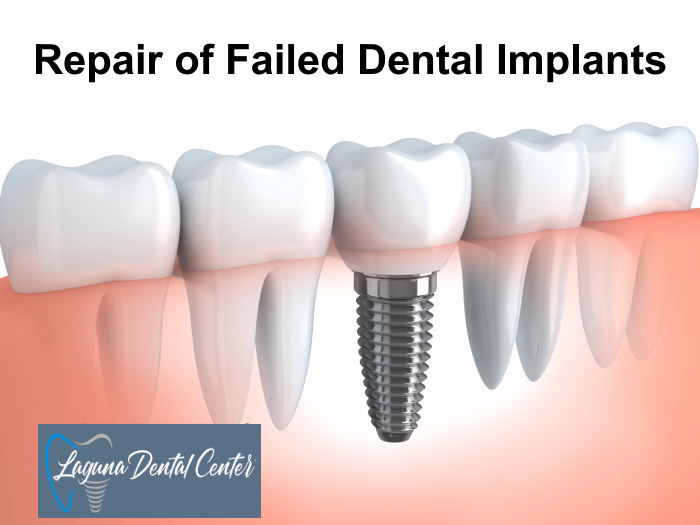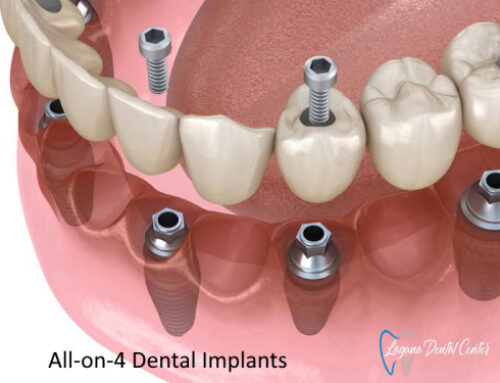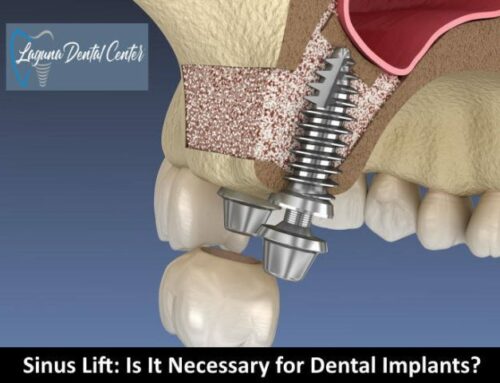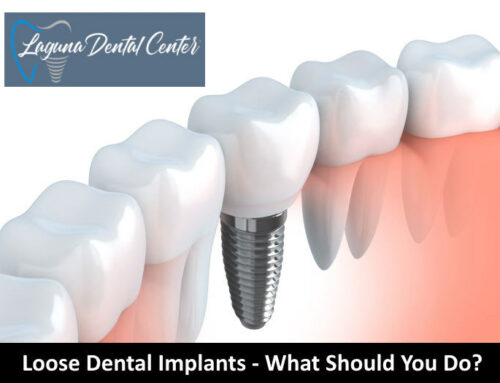Table of Contents

What are the symptoms of a failing dental implant?
Here are five signs of failed tooth implants.
- Slight shifting or loosening of the dental implant
- Extreme pain or discomfort
- Gum recession around the tooth implant
- Difficulty in chewing or biting
- Inflammation of the gums
Your dentist will be able to repair your failed tooth implant by taking an x-ray to determine what caused your dental implant to fail. The best treatment for dental implant repair can be chosen by determining the main cause of the implant’s failure.
What are the causes of failed dental implants?
Dental implants have a failure rate of 3.11% according to a study published in the Journal of Oral Medicine and Oral Surgery. Infection, lack of jawbone density, lack of primary stability, surgical trauma, and sinus problems are some of the most common signs of early dental implant failure. A dental implant failure after 10 years can be caused by nerve damage, peri-implantitis, failed osseointegration, and occlusal loading.
Infection
The most typical reason for failing dental implants is an infection at the implant site. The signs of the bacterial infection known as peri-implantitis include swelling of the peri-implant mucosa and a progressive loss of the bone that supports the dental implant. Bacterial growth just below the gum line, near the dental implant, is what causes peri-implantitis. The infection’s location and severity will determine how it should be treated. For instance, medications or soft tissue grafts may be necessary to treat a gum infection brought on by peri-implantitis. If a bone infection caused by bacteria develops, the implant and any affected bone tissue might need to be removed. A bone grafting and soft tissue graft would come next.
Lack of Bone Mass
The existence of healthy bone and enough bone mass has a major impact on the success rate of dental implant surgery. The tooth implant could become loose due to insufficient jawbone density, which would result in dental implant failure. Your dentist will evaluate the health of your bone prior to the procedure. If there is insufficient bone, bone grafting or a sinus lift may be done before implant surgery. Through bone grafting, the patient’s jawbone mass and volume will increase.
Failed Osseointegration
Osseointegration is when the tooth implant integrates with the jawbone. A common cause of failed osseointegration is changing the treatment plan that inhibits osseointegration between the implant surface and the surrounding bone. Infection, inadequate implant placement, dental implants made of subpar materials, trauma during or after surgery, inadequate healing, early loading, and allergic rejection of foreign substances by the body are other common causes of failure osseointegration.
Signs of Peri-implantitis
Peri-implantitis is an inflammatory condition that can cause the jawbone where the dental implant is positioned to gradually deteriorate. Below are eight signs of peri-implantitis.
- There is pain near the location of your dental implant.
- The dental implant is loose.
- The dental implant threads are exposed and visible.
- The lymph node is inflamed.
- There is bleeding at your gum line.
- The tissues surrounding your implant are oozing pus.
- The periodontal pockets are deeper around the dental implant.
- There is a bad taste in your mouth.
Sinus Problems
The inflammatory byproducts of acute sinusitis can hinder the osseointegration of dental implants, bone remodeling, and osteoconduction of bone graft material. This could ultimately result in dental implant failure. Failed dental implants may result from perforated sinuses. The symptoms of perforated sinus after dental implant procedure include whistling sounds when breathing in, nasal pressure, breathing difficulties, loss of smell, and bleeding. Perforations of one or two millimeters can be controlled. But persistent issues frequently result from perforations that are several millimeters wide. Certain patients who have sinus perforations after receiving dental implants may experience chronic nasal problems, necessitating the removal of the crown, bone grafting, healing of the site, and placement of a replacement implant.
Tissue or Nerve Damage
Although rare, an oral surgeon could unintentionally place a dental implant too close to a nerve. Your gums, tongue, lips, or face may experience numbness, tingling, or soreness as a result., You mustn’t ignore the numbness you are feeling because it might affect your regular capacity to eat and drink. If you’re in pain or experiencing numbness, you should visit your dentist right away since a nerve or tissue problem needs to be treated immediately.
How do you treat a failing dental implant?
Dental implant failure brought on by peri-implantitis is often treated by sterilizing the implant site and removing infected tissue. Failed dental implants caused by a lack of jawbone density will require a bone graft before your dentist can replace the failed dental implants with new ones. Your jawbone can gain volume and density where there has been bone loss with the aid of a bone graft.
Can a chipped dental implant be fixed?
Yes, a dental implant that is damaged or chipped can be fixed. A qualified dentist must use a specialized composite material to do all required repairs to fix a chipped dental implant. However, if the damage is extensive, it may require to completely replace the dental implant. Before installing a new tooth implant, you might need a bone graft to strengthen your jawbone and make sure there is enough density.
How do you repair a damaged dental implant crown?
An artificial tooth that is attached to a dental implant is called a dental implant crown. A dental implant crown is as strong and durable as a natural tooth. But chewing ice, consuming hard candies, and biting your fingernails can all result in the fracturing, chipping, or cracking of an implant crown. If the crown cracks or breaks, impressions of the mouth will be taken and sent to a dental lab. The damaged crown will then be removed and replaced with a brand-new one.
How do you repair a damaged dental implant abutment?
An abutment is a metal piece that is attached to your dental implant. The dental implant crown is firmly fixed in place by the abutment. An abutment can crack if it has substantial wear and tears. If the abutment is broken, your dentist will only need to repair the abutment and not the entire dental implant.
What is the success rate of Dental Implant Surgery?
A dental implant has a success rate of 90–95% as per the study published in the International Journal of Implant Dentistry. The installation of teeth implants will be successful if 4 main variables are present. These variables include good oral and overall health, the dentist’s expertise, high-quality dental implant materials, and the absence of periodontal diseases and major medical conditions.
How can dental implant failure be prevented?
Dental implant failure can be prevented if you follow the recovery guidelines provided by your dentist. You must also attend your follow-up sessions on time so that your dentist may evaluate how well your treatment is going. If you want to avoid problems with your dental implant, you must practice proper oral hygiene daily. Moreover, you must not smoke because doing so will only slow down your healing.







